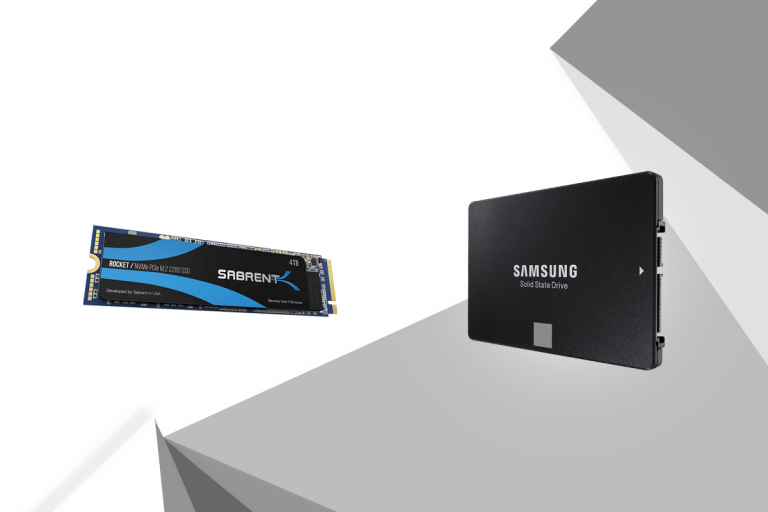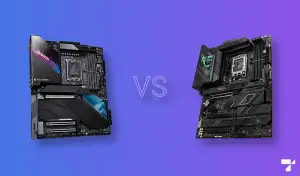With SSDs being the ideal storage choice for consumer devices like laptops, desktops, and consoles, manufacturers are increasingly pushing the technology to higher capacities. If low storage capacity was a cause for avoiding SSDs in the past, now’s the time to reconsider as larger capacity SSDs are becoming more prevalent. More specifically, 4TB SSDs are finally going mainstream, driving manufacturers to cut prices significantly. Therefore, we have carefully crated this list of the best 4TB SDDs.
You can thank TLC or Triple Level Cell flash NAND technologies for high-storage 4TB SSDs. Compared to older SLC and MLC SSDs, manufacturers can pack more storage in the same form factor and keep costs low. QLC or quad-level cell technology SSDs are also good, though we would recommend them for 8TB SSDs as they are slower and depend highly on their SLC cache, which fills up fast on lower capacity SSDs.
However, with so many 4TB SSD options available in the market, it’s tough to determine which one is best for you. Luckily, we did the research and developed this comprehensive list of 4TB SSDs to help you make the right choice as these SSDs cost a lot. We have also included M.2 NVMe, SATA, and external 4TB SSD variations for you to choose from based on your computing storage needs.
Best 4TB M.2 NVMe SSDs
1. Sabrent 4TB Rocket
Specifications:
Capacity:256GB, 512GB, 1TB, 2TB, 4TB | Controller: Phison PS5012-E12S | Memory: Kioxia BiCS3 96L 3D TLC | Interface: M.2 PCIe 3.0 x4 | Sequential read: 3,450MB/s (4TB version) | Sequential write: 3,000MB/s (4TB version)Key features:
- Fast TLC flash NAND with DDR4 cache
- Sabrent Acronis True Image software included for free
- 5-year warranty (1 year without registration)
Sabrent’s Rocket SSD manages to pack quite a lot of storage in the M.2 2280 form factor. The SSD employs TLC flash to store a large amount of data in such limited space. The SSD’s read and write performance is rated at 3,450 and 3,000 MB/s, with a real-world performance expected to be around the average for NVMe SSDs, a testament to the TLC flash NAND used.
Apart from the drive itself, Sabrent offers several features like a free version of the Acronis True Image software, a five-year warranty, and even a free aluminum case if you need to store your SSD externally. You also get a five-year warranty, provided you register the device on Sabrent’s website within 90 days of purchase.
The Rocket utilizes the Phison E12S controller, which is smaller than the traditional E12, letting the SSD use the extra space for the additional flash modules. Kioxia manufactures the TLC flash used in the Sabrent Rocket SSD. With an increase of newer high-capacity SSDs like Sabrent’s own Rocket Q launching with QLC, it’s not long before drives like this become scarce.
With a rough estimate of a 3000 TBW capacity, the Sabrent Rocket 4TB SSD should last you a fair bit of time. While SLC and MLC are way better in endurance, we hardly find any of them in the 4TB capacity anyway, so this is the best you can get. With a price tag of $699.99, the SSD is pretty expensive but is way more valuable if the applications you work with can use high speeds.
2. Corsair Force Series MP510
Specifications:
Capacity:240GB, 480GB, 960GB, 1920GB, 4000GB | Controller: Phison PS5012-E12S | Memory: Toshiba BiCS3 96L 3D TLC | Interface: M.2 PCIe 3.0 x4 | Sequential read: 3,480MB/s (4TB version) | Sequential write: 3,000MB/s (4TB version)Key features:
- 5-year warranty
- DDR3 cache with fast TLC NAND
- SSD Toolbox included for advanced control
With the demand for 4TB SSDs increasing, more manufacturers are beginning to expand their lineup of NVMe M.2 SSDs in a bid to get a slice of the pie. Although it’s way easier to produce QLC SSDs at this capacity, a few manufacturers still make TLC drives, with Corsair’s MP510 being an excellent example of a 4TB SSD available right now.
The MP510 features a write speed of 3,000MB/s and a read speed of 3,480MB/s, making it one of the fastest 4TB SSDs out there. With a Phison E12S controller, a smaller and better-cooled version of its E12 predecessor, a 96-layer TLC flash from Toshiba, and a DDR3 cache, the MP510 is certainly a decked out SSD.
The M.2 2280 size of the SSD makes it ideal for devices like laptops, where the additional 4TB of storage is a bonus if you’re prone to travel frequently. The 6820 TBW endurance rating of the SSD makes it the right choice if you’re looking to use it to run heavy applications that can use the extra speed.
At $744.99, the MP510 nets you a fast and reliable SSD, a five-year warranty, and the Corsair SSD Toolbox software. It might be more expensive than other similar TLC SSDs, but being one of the fastest SSDs out there with an equally impressive endurance makes it worth the price premium.
3. XPG S40G
Specifications:
Capacity:256GB, 512GB, 1TB, 2TB, 4TB | Controller: Realtek RTS5762 | Memory: Micron 96L 3D TLC | Interface: M.2 PCIe 3.0 x4 | Sequential read: 3,500MB/s (1TB version) | Sequential write: 3,000MB/s (1TB version)Key features:
- RGB Lighting compatible with sync software
- 5-year warranty
- DDR3L cache
If you’re looking to show off your blazing fast NVMe SSD in your PC build, then the XPG S40G from ADATA is the best choice for you. Sporting RGB LEDs on either side, the S40G also syncs with your motherboard to be compatible with your existing RGB software. The 4TB capacity is the XPG S40G’s latest release, and it performs well with a top read and write speed of 3500 MB/s and 3000 MB/s, respectively.
The SSD’s RGB takes up a bit more space than a typical M.2 SSD, making it the ideal choice for PC motherboards as laptops have very tight space constraints and will cover up the RGB. The Realtek RTS5762 controller is not what you would find on standard 4TB NVMe SSDs, but it nevertheless performs on par with the other NVMe SSDs available in the market.
The SSD also employs a Micron TLC flash memory, which is again much faster and longer-lasting than the QLC NVMe drives sold today.
The S40G does have some quirks, though. Its RGB software is pretty buggy and makes the RGB on the SSD almost unusable. Add to this the inadequate cooling due to the LEDs’ plastic being thermally insulating, forcing the drive to shut down after some time.
For a price tag of $599.99, the ADATA XPG S40G is the cheapest 4TB NVMe SSD with a TLC flash NAND for sale on the market. Its limited support for laptops, buggy software, and insufficient cooling keep it from being the best, and we would recommend spending extra if your data is mission-critical.
4. WD Black 4TB AN1500
Specifications:
Capacity:1TB, 2TB, 4TB | Controller: Marvell 88NR2241 | Memory: WD 96L 3D TLC | Interface: PCIe 3.0 x8 | Sequential read: 6,500MB/s (4TB version) | Sequential write: 4,100MB/s (4TB version)Key features:
- RAID0 PCIe Gen3 x8 configuration for faster speeds
- WD Black Dashboard software included
- 13 LED RGB lighting
The WD Black AN1500 is different from the typical 4TB NVMe SSD you would usually find on the market. While some manufacturers use the M.2 interface to transfer data at high speeds, WD instead opts for the PCIe 3.0 x8 slot via an add-in card. To fully utilize the PCIe 3.0 x8 slot, the AN1500 employs two 2TB NVMe SSDs in the RAID0 configuration. This configuration allows the SSD to reach a write speed of 4,100 MB/s and a read speed of 6500 MB/s.
The AN 1500 features an enterprise-level RAID controller and two WD Black SN750 NVMe SSDs. A plug-and-play RAID0 configuration such as this makes it extremely easy to achieve high speeds without the need to source SSDs and a custom PCIe add-in card with a RAID controller separately.
It still utilizes TLC SSDs, so the endurance and speeds will not be as good as you would get with an SLC or MLC SSD. WD’s five-year warranty is also a great addition as the endurance of a RAID0 configuration like this is not easy to calculate. The AN1500 also comes with RGB LEDs to spruce up your PC’s lighting and should seamlessly sync with existing control software.
For $999, the add-in card is the most expensive 4TB SSD you can currently buy. Newer PCIe Gen4 SSDs matching the AN1500 in speed is a better option to consider once they and the motherboards and CPUs that support them go mainstream. However, most people with existing hardware can consider the WD Black AN1500 is the fastest you can go with a 4TB SSD right now.
Best 4TB SATA SSDs
1. Samsung SSD 860 EVO
Specifications:
Capacity:250GB, 500GB, 1TB, 2TB, 4TB | Controller: Samsung MJX | Memory: Samsung 64L 3D TLC | Interface: SATA III | Sequential read: 550MB/s (4TB version) | Sequential write: 520MB/s (4TB version)Key features:
- ECC algorithm for faster speeds and broader compatibility
- Samsung Magician Software included
- AES 256-bit hardware-based encryption supported
Samsung has long been the popular SSD of choice for many buyers due to its high-quality components, leading performance, and endurance. The 860 Evo is Samsung’s consumer SATA SSD that comes with speeds of 550MB/s and 520 MB/s for read and write, respectively. Samsung utilizes its own TLC flash V-NAND, the technology that gives an edge over competitors.
The top feature of the EVO that Samsung advertises is its endurance, with a 2,400 TBW rating for the 4TB model. The drive also comes with an MJX controller developed again by Samsung, which contains unique error-correcting algorithms for better endurance and compatibility with Linux systems. The SSD also comes with a DRAM flash that works with software to reduce wear and increase speeds.
Samsung includes software for managing the drive and migrating your data. The drive’s solid endurance and durable build make it a great alternative to hard drives that share a similar form factor connector. For a price tag of $440.50, the 860 EVO is the right choice for you if you prefer endurance over speed. Its performance does fall behind the other SATA SSDs on the market, but its prices are lower than the competition to make up for it.
2. Western Digital WD Blue
Specifications:
Capacity:250GB, 500GB, 1TB, 2TB, 4TB | Controller: Marvell 88SS1074 “Dean” | Memory: SanDisk 64L 3D TLC | Interface: SATA III | Sequential read: 560MB/s (4TB version) | Sequential write: 530MB/s (4TB version)Key features:
- 3-year manufacturer warranty
- Compatible with a wide range of computers
- Free Acronis software included
The WD Blue is one of the best-performing SSDs when it comes to the SATA interface. The drive manages to reach speeds of 560MB/s read and 530MB/s write, faster than offerings from Samsung like the 860 EVO. The WD Blue comes with the standard TLC flash used in most 4TB SSDs, offering a blend of price, performance, and capacity.
The WD Blue uses the Marvell 88SS1074 controller paired with 2 LPDDR3 modules used for caching. Write endurance on the SSD is way lower than Samsung’s models, coming in at 600 TBW for the 4TB model. The Blue follows the 2.5-inch form factor of other SATA SSDs and is a suitable replacement for hard drives.
With a net price of $462.14, the WD Blue offers many additional features that include the Acronis True Image software for easy transfer from your existing storage devices. Our recommendation of the 4TB WD Blue is for those looking for a fast SSD for regular use. The 3-year warranty and lower endurance make it a bad choice for those needing an SSD that will last them a long time, with Samsung drives being our recommendation instead.
3. SAMSUNG 860 PRO
Specifications:
Capacity:256GB, 512GB, 1TB, 2TB, 4TB | Controller: Samsung MJX | Memory: Samsung 64L 3D MLC | Interface: SATA III | Sequential read: 560MB/s (4TB version) | Sequential write: 530MB/s (4TB version)Key features:
- Samsung Magician management software included
- AES 256-bit encryption
- 5-year manufacturer warranty
If the 860 Evo did not live up to your endurance expectations, the 860 Pro would undoubtedly exceed them. It not only offers a massive 4,800 TBW endurance but also manages to provide a solid read and write speed of 560MB/s and 530MB/s, respectively. Add to this the option for hardware-backed AES 256-bit encryption, and you’ve got a reliable enterprise-grade storage solution.
The 860 Pro utilizes the company’s in-house MJX controller, enhanced with error-correcting algorithms that improve the drive’s endurance and performance. The new controller also works well with Linux systems, making it ideal for the open-source operating system’s users.
The SSD’s Samsung 64-layer 3D MLC V-NAND is the best you can get in any 4 TB SSD and is responsible for extraordinary durability while maintaining a high speed. The SSD also comes equipped with 4GB of LPDDR4 memory for caching, which is pretty impressive, considering it’s just an SSD.
With a price tag of $689.89, the Samsung 860 Pro is as expensive as an NVMe SSD, and honestly, paying so much is overkill for a SATA SSD. Unless you plan to use the SSD in a RAID array and utilize it at a very high frequency, the 860 Pro is not the SSD for you. Considering the drive has a five-year warranty, similar to other manufacturers, the high write endurance you will be paying for will undoubtedly be unrealized for most customers leading to a waste of money.
4. SanDisk Ultra
Specifications:
Capacity:250GB, 500GB, 1TB, 2TB, 4TB | Controller: Marvell 88SS1074 “Dean” | Memory: SanDisk 64L 3D TLC | Interface: SATA III | Sequential read: 560MB/s (4TB version) | Sequential write: 530MB/s (4TB version)Key features:
- Economic pricing
- 5-year manufacturer warranty
- nCache 2.0 for faster burst speeds
If a cheap and high-performance SSD is all you need, the SanDisk Ultra is the choice for you. It manages to offer just the SSD without any additional software and features that are important for operation. The SSD comes with a read speed of 560MB/s and a write speed of 530MB/s, the farthest you can go with a SATA SSD.
On the inside, the SanDisk is virtually identical to the WD Blue featuring the same Marvell 88SS1074 controller and LPDDR3 module setup. It also employs its in-house developed 64-Layer TLC flash NAND, the same as the WD Blue. The disk’s endurance stands at 600 TBW with a more extended five-year warranty, which is enough for most buyers with regular use cases.
Costing $494.99, the SanDisk Ultra 4TB SSD is more expensive than the WD Blue, and it trades the free software for an additional two-year warranty. While most users will not exceed the drive write endurance in three or even five years, power users will be better off using Samsung TLC SSDs for their higher endurances, which is necessary if reliability is important to you.
Best 4TB External SSDs
1. Oyen Digital U32 Shadow
Specifications:
Capacity:500GB, 1TB, 2TB, 4TB, 8TB | Controller: ASMedia 235CM | Memory: 92L 3D TLC | Interface: USB-C (3.1 Gen 2 10Gbps) | Sequential read: 550MB/s (8TB version) | Sequential write: 550MB/s (8TB version)Key features:
- Sleek aluminum housing
- 3-year warranty
- Padded carrying case included
The U32 Shadow from Oyen Digital is an external SATA SSD that comes in a durable and well-designed aluminum chassis. The external drive sources SATA SSDs from several manufacturers, so pinpointing its exact endurance and transfer speeds will not be possible. However, Oyen mentioned that the maximum transfer rate is capped at 550 MB/s.
The drive uses an ASMedia 235CM controller to enable data transfer over USB-C. The controller supports both UASP and TRIM, letting the SSD perform the best even over USB. The drive can connect via a USB C-to-C cable for high-speed data transfer.
The drive’s endurance is also not fixed due to the different manufacturers of the internal SSDs. Considering its and external drive, we believe most users will not need to worry about wearing out their SSD within the drive’s 3-year warranty period.
Coming in at $599.00, the Oyen Digital is certainly not cheap, especially considering internal 4TB NVMe drives like the Sabrent 4TB Rocket is available for $100 more. If you’re looking to use the SSD with a laptop, then an M.2 NVMe is a much better choice as it’s faster and easy to use.
2. VectoTech Rapid
Specifications:
Capacity:1TB, 2TB, 4TB, 8TB | Controller: Silicon Motion SM2258G | Memory: Micron 96L 3D QLC | Interface: USB 3.1 Gen 2 | Sequential read: 540MB/s (8TB version) | Sequential write: 540MB/s (8TB version)Key features:
- Premium and durable aluminum build
- 3-year manufacturer warranty
- Vibration and shock-resistant
The VectoTech Rapid is another external drive that utilizes a SATA SSD enclosed in an outer aluminum shell with sides made of plastic. The VectoTech Rapid aims to service both Windows and Mac systems thanks to its exFAT formatting, making it a handy device if you frequently transfer files.
With a speed of 540MB/s and UASP support, the drive will function great over the USB 3.1 Gen 2 connection. The included cables are for both USB-C and USB-A devices, so compatibility with older computers is also guaranteed. The aluminum build also makes the drive shock and vibration-proof up to a certain extent.
With the VectoTech Rapid costing $559.00, it is a viable option for those looking for a well-performing external drive that can be transported easily. If you have a laptop with a soldered SSD or no available slots for M.2 or SATA devices, the VectoTech is an ideal option. In any other case, an internal SSD will be much more worth it.
NVMe VS. SATA SSDs
Most SSDs on the market today come with either one of two interfaces, NVMe or SATA. NVMe is a relatively new interface that employs PCIe to transfer data from the host’s storage device at much higher speeds. SATA, on the other hand, being initially developed for hard drives, is much slower and can only output a maximum transfer rate of 6Gbps.
NVMe speeds are instead capped on the number of PCIe lanes, with a typical PCIe 3.0 x4 connection having a speed of 16Gbps. This speed variation gives rise to the differences in NVMe and SATA SSDs. All NVMe SSDs come with either the M.2 or PCIe connectors. Today, most SATA SSDs are still available in the 2.5-inch form factor, but some employ the M.2 interface but are slower than M.2 NVMe.
At their core, all SSDs utilize the same technology for storage. To accommodate larger capacities while maintaining the same form factor, most manufacturers use Triple Level Cell flash, more commonly known as TLC flash NAND. This flash structure stores three bits per cell compared to the two and one bits per cell of MLC and SLC cache, respectively. TLC does come with its shortcomings, though. It has a much lower write speed and endurance than MLC and SLC.
Final Thoughts
In the end, the 4TB SSD you choose is solely dependent on how much speed, endurance, and portability you need. While 4TB SSDs do not have a significant price difference between SATA and NVMe, choosing the right one for your needs will ultimately lead you to save quite a bit of money. So, go through and decide the best one from our handy list. We hope that you found this article helpful and informative.



